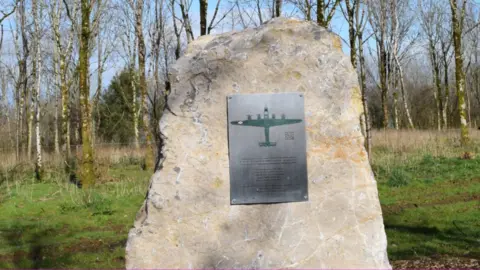Plaque honours 80th anniversary of Blagdon plane crash
 The Blagdon History Society
The Blagdon History SocietyA plaque has been unveiled to mark the 80th anniversary of when a US military plane crashed, killing five men.
Five others survived the crash, which happened at Blagdon in North Somerset in the final months of the Second World War.
Blagdon Local History Society made the plaque and a representative of the US Air Force spoke at the ceremony.
Brian Durbin, who saw the plane overhead shortly before it crashed when he was a schoolboy, also attended.
On 14 March, 1944, some three months before D-Day, the B-24J Liberator four-engine bomber set off on a flight from America to Europe.
 Blagdon Local History Society
Blagdon Local History SocietyIt flew from Florida to the island of Bermuda and across the Atlantic to Marrakesh in Morocco.
From there it set out to fly to RAF Valley, on Anglesey.
Bad weather there caused the crew to try to divert to St Mawgan in Cornwall.
Having lost their bearings, they found Filton Airfield where flares were lit to help them land, but they aborted their first attempt at a landing.
Making a sweep round, the plane then passed over Blagdon Lake before clipping the tops of trees on The Mendip Hills and crashing near Hazel Farm, about a mile south of Ubley and Compton Martin.
 The Blagdon Local History Society
The Blagdon Local History SocietyInvestigators concluded the crash probably resulted from a combination of factors.
These included the crew being inexperienced and only recently out of training, tired after a long flight and facing poor weather conditions while flying over unfamiliar territory which they were unlikely to have maps for.
Today a well-used footpath - part of both The Monarch's Way and The Limestone Link - passes through the site.
The stone and plaque was placed on the verge of this path overlooking the field in which the plane came down.

Follow BBC Somerset on Facebook and, X. Send your story ideas to us on email or via WhatsApp on 0800 313 4630.
